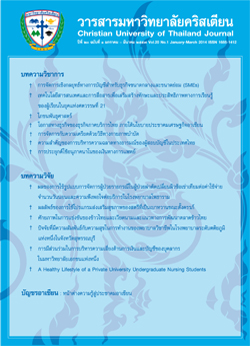รูปแบบการดำเนินชีวิตแบบสุขภาพดีของนักศึกษาพยาบาล ระดับปริญญาตรีมหาวิทยาลัยคริสเตียน
บทคัดย่อ
วัตถุประสงค์ของการทำวิจัยในเชิงสำรวจและทดลองครั้งนี้เพื่อศึกษาว่านักศึกษาพยาบาลของมหาวิทยาลัยเอกชนแห่งหนึ่งตระหนักถึงรูปแบบการดำเนินชีวิตแบบสุขภาพดีหรือไม่และปฏิบัติตามแนววิถีชีวิตในระดับใดรวมถึงการศึกษาว่ามีความแตกต่างอย่างมีนัยสำคัญหรือไม่ระหว่างตัวแปรในด้านประชากรความตระหนักและปฏิบัติตัวต่อรูปแบบการดำเนินชีวิตแบบสุขภาพดี
รูปแบบการดำเนินชีวิตแบบสุขภาพดีวัดได้จากพฤติกรรมการกินและการดื่ม,การนอนหลับพักผ่อนและการผ่อนคลายกิจกรรมด้านกายภาพและการออกกำลังกาย,การทำสมาธิ,การจัดการความเครียด,พฤติกรรมด้านการใส่ใจต่อสุขภาพ เช่น การดูทีวีการใช้คอมพิวเตอร์เป็นระยะเวลาหลายชั่วโมงและพฤติกรรมการสูบบุหรี่กลุ่มตัวอย่างประกอบด้วยนักศึกษาปริญญาตรีของมหาวิทยาลัยคริสเตียนจำนวน 70 คนซึ่งมีความแตกต่างกันในเรื่องของอายุเพศพื้นฐานการศึกษาของผู้ปกครอง, ที่อยู่อาศัยปัจจุบัน,รายได้ต่อเดือนของผู้ปกครอง, ปัญหาสุขภาพ,ปัญหาด้านการเงินและศาสนาสมมติฐานก็คือนักศึกษาพยาบาลเหล่านี้มีความเชื่อและปฏิบัติตัวตามรูปแบบการดำเนินชีวิตแบบสุขภาพดี
ผลการศึกษาพบว่านักศึกษาพยาบาลมหาวิทยาลัยเอกชนแห่งหนึ่งตระหนักถึงความสำคัญของรูปแบบการดำเนินวิถีชีวิตเพื่อสุขภาพที่ดีแต่ยังขาดความสม่ำเสมอและความต่อเนื่องในการปฏิบัติตัวตามรูปแบบที่กำหนด ซึ่งสอดคล้องกับผลงานวิจัยที่ผ่านมา ที่ศึกษาเกี่ยวกับการศึกษาทางการพยาบาล พบว่า มีช่องว่างระหว่างความรู้ทางทฤษฎีและการฝึกปฏิบัติ คือแม้ว่านักศึกษาพยาบาลจะตระหนักและรู้เกี่ยวกับแบบแผนการดำเนินชีวิตเพื่อสุขภาพที่ดี แต่ก็ไม่ได้เกิดพฤติกรรมการปฏิบัติที่เป็นไปตามรูปแบบที่กำหนด ดังนั้นจึงควรศึกษาเพิ่มเติมในการใช้แนวคิดเรื่อง การตระหนักรู้ด้วยตนเอง และการใช้แรงจูงใจ เพื่อให้เกิดพฤติกรรมการปฏิบัติที่สม่ำเสมอและต่อเนื่อง
เอกสารอ้างอิง
Anderson, T. Elizabeth and McFarlane Judith. (2008). Community as a Partner. Wolters Kluwer/Lippincott Williams &Wilkins.
Brach, J.S., Simonsick, E. M., Kritchevisky, S., & Newman, A.B. (2008). The association between physical function and lifestyle activity and exercise in the health, aging, and body composition study. Journal of the American Geriatric Society, 52 (4), 502-509.
Chery, L. P. Lynch, Melba A. Hernandez-Tejada, Joni L. Strom, Leonard E. Egede, (2013). Interrelation Between Adult Persons With Diabetes and Their Family : A Systematic Review of the Literature. Journal of Family Nursing, 1(19); 3-28.
Cho, H.A., YamaratK.(2014).Factors Associated with IUD service Productivity of Sun quality of Sun Quality Health Doctors in Myamar. Journal of Health Research. 28(2), 46-48.
Fawcet, Jacqueline, De Santo-Madeya Suzan. (2013). Contemporary Nursing Knowledge : Analysis and Evaluation of Nursing Models and Theories. New York : FA Davis Company.Gallicchoi L.
Gallicchio L, Hoffman SC, Helzlsouer KJ. (2007) .The relationship between gender, social support, and health-related quality of life in a community-based study in Washington County, Maryland. Quality of Life Research Journal. 16(5), 77-86.
Harford, C. Thomas, Wechster Henry, MuthenBengt O. (2002). The Impact of Current Residence and High School Drinking on Alcohol Problems among College Students. Journal of Studies on Alcohol and Drugs. 63(3) : 206 -207
Hjartaker, A., Lund E. (1998). Relationship between dietary habits, age, lifestyle, and socio-economic status among adult Norwegian women. The Norwegian Women and Cancer Study.European Journal of Clinical Nutrition. 52(8), 65-72.
Hong, J. F., Sermsri, S., & Keiwkarnka, B. (2007). Health-promoting lifestyles of nursing students in Mahidol University. Journal of Public Health and Development.5(1), 50-57.
Hummel, J. (2001). Population-based medicine : Link to public health. Textbook of Rural Medicine. New York : MacGawHill.
Lahey, B. Benjamin. (2007). PSYCHOLOGY: an introduction. 9th Edition. San Francisco : McGraw Hill.
Leyland, A. H., & Naess, o. (2009). The effect of area of residence over the life course on subsequent mortality. Journal of the Royal Statistical Society: Series A (Statistics in Society), 172(3), 555-578.
McCrink, Andrea. (2010). Academic Misconduct in Nursing Students : Behaviors, Attitudes, Rationalizations, and Cultural Identity. Journal of Nursing Education. 49(11), 653-660.
Mckee, Martin, Knai Cecile. (2010). Tackling Childhood Obesity : the importance of understanding the context. Journal of Public Health. 32(4), 506-511.
Pender, N., Murdaugh C., Parsons M.A. (2011). Health Promotion in Nursing Practice. Sixth Edition. New York : Pearsons
Perry, A., Potter A. P, Ostendorf W.(2010). Clinical Nursing Skills and Techniques. New York : MOSBY Elsevier.
Santrock, W. John. (2005). PSYCHOLOGY. 7TH Edition. Toronto : McGraw Hill.enol, V., nalan, D., Soyuer, F., & Arg n, M. (2014). The Relationship between Health Promoting Behaviors and Quality of Life in Nursing Home Residents in Kayseri. Journal of Geriatrics. 14(2),214-216.
Scully, N.J. (2011). The Theory-Practice Gap and Skill Acquisition : an issue of nursing education. Collegia (Royal College of Nursing, Australia, 18(2), 93-98.
Shriver, C, Scott-Stiles A., (2000). Health Habits on Nursing Versus Non-Nursing Students : A longitudinal Study. The Journal of Nursing Education. 39(7), 308-314.
Tonges, Mary, Ray Joel. (2011). Translating Caring Theory Into Practice : The Carolina Care Model. The Journal of Nursing Administration. 41(9),374-381.
Turris, Rob, Mallet A. Kimberly, Mastreleo Nadine. (2006). Heavy Drinking in College Students : Who is at Risk and What is Being Done About It?. National Institute of Health. 133(4), 401-420.
Winkleby, M A, Jatulis D, Frank E., and Fortmann, S.V. (1992). Socioeconomic status and health : how education, income, and occupation contribute to risk factors for cardiovascular disease. American Journal of Public Health. 82(6), 816-820.
Yeager, J.J. (2013). Delirium Superimposed on Charles BonetSyndrom : A Case study. Geriatric Nursing. 34(6),453-456.
Yeh, L., Chen CH, Wang CJ, Wen MJ, Fetzer S.J. (2005). A Preliminary Study of a Healthy Lifestyle - Promoting Programs for Nursing Students in Taiwan. Journal of Nursing Education, 44(12), 563-565.



